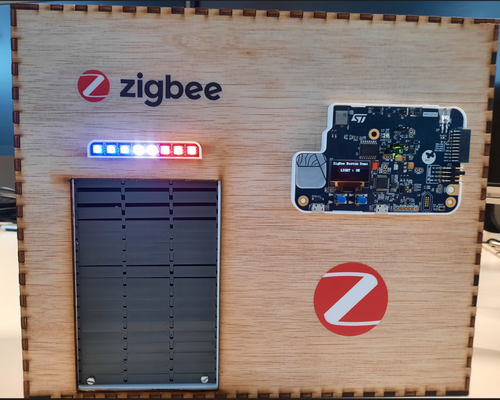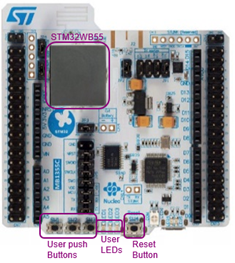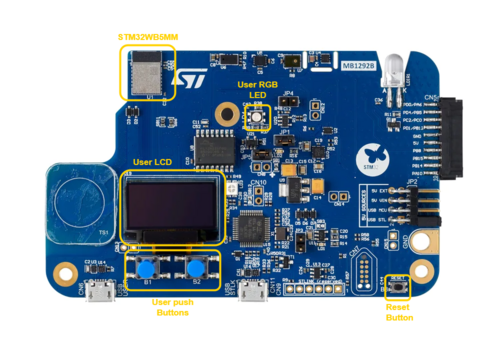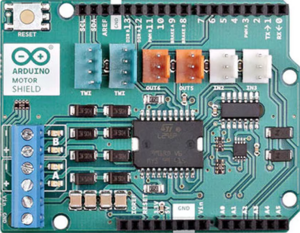For the sake of brevity, we will refer to Realistic Use Cases (RUC) as an abbreviation throughout this discussion.
1. Introduction
This implementation can be seen as an extension of the Wiki: Zigbee RUC Lighting [1], adding another Zigbee cluster for the Home automation aspect.
To test and verify various functionalities and ensure proper functioning, this approach mixes and maintains several devices with different clusters on the same network.
2. Getting started
To the Wiki: Zigbee RUC Lighting[1], this project adds a Window Device as Router (ZR) and a Window Controller as End Device (ZED) for Window covering features.
2.1. Hardware requirements
Both a P-NUCLEO-WB55 Pack [2] and an STM32WB5MM-DK[3] are required to set up the demonstration.
For more information, please visit STM32WB Development ecosystem
In addition, it uses an Arduino Motor Shield Control (AMS) [4] based on the ST dual full-bridge driver L298P [5] to drive a DC motor, enabling the real opening and closing of a window covering.
DC motor specification: 12v, 80rpm
2.2. Software and system requirements
All applications are available on the Github hotspot:
- Zigbee_Coord
- Zigbee_Shutter_Remote
- Zigbee_Roller_Shutter
For more information on how to build the Zigbee application, refer to STM32WB Build Zigbee Project
To check messages from the board, use any convenient terminal software via the UART Interface, refer to Wiki: Zigbee Log via UART
One driver was created for Arduino Motor Shield, and can be found with source example.
See below the Server cluster side for more information.
2.3. Install the Zigbee network
To install the RUC example, follow the Wiki: RUC - HowTo Join a Zigbee Network and Wiki: RUC - HowTo bind devices.
3. Zigbee Implementation
This example uses the Zigbee cluster Window Covering [6] with the following topology:
- a Window Covering as ZR with server cluster
- a Window Covering Controller as ZED with client cluster
3.1. Window Covering
The server is based on a STM32WB5MM-DK [3], with a slot to put an Arduino board to expand its functionality.
It uses an Arduino Motor Shield Control (AMS) [4] based on the ST dual full-bridge driver L298P [5] to drive a DC motor, enabling the real opening and closing of a window covering.
One driver was created to enable the following functionalities:
- Adjust the motor’s speed by modifying the duty cycle of a PWM (driven by a GPIO connected to a timer).
- Change the rotation direction (driven by a GPIO).
- Set a break (also driven by a GPIO)
- Current sensing, with that possibility, this feature detects when the window covering is stuck and stops the motor.
3.2. Window Covering Controller
The client is based on a board P-NUCLEO-WB55 [2] where Switch 1/2/3 on the board appear as Up/Stop/Down commands.
The client cluster of the Window Covering[6] implements 7 commands but only three commands are used.
- Up / Open
- Down / Close
- Stop
As with the previous example, these commands are associated with callbacks functions on the server side. When an UP command is sent, the corresponding callback function on the server side, initiates the motor rotation to open the window covering.
3.3. Binding and Report process
This use case reuses the same process as in: Wiki: Zigbee RUC Lighting.
4. Possible Extension
An extension exists to add the Alarms cluster [7] to notify when the shutter is blocking and to flash the LEDs controller to warn the User.
5. Acronyms and definitions
| Term | Definition |
|---|---|
| ZC | Zigbee Coordinator |
| ZR | Zigbee Router |
| ZED | Zigbee End Device |
| RUC | Realistic Use Case |
| AMS | Arduino Motor Shield |
| GPIO | General Purpose Input Output |
| PWM | Pulse Width Modulation |
| DC motor | Direct Current motor |
6. References





